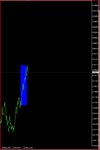trendie
Legendary member
- Messages
- 6,875
- Likes
- 1,433
OK. You have a system. It seems to work.
You have quantified your system. Its consistent.
Next step is scaling up.
I dont get this increasing each trade by a small fraction, ie, by a fraction of a £pound per pip. It looks great on a spreadsheet, but realistically, you may decide to only increase trade size by a full £pound per pip.
So, whats wrong with the following thought process?!
Starting account: £1,500. (arbitrary value)
You trade £1 a pip until you nett 600 pips overall. (that is, your account size has to grow to £2,100).
NB: You are risking 20-30 pips per trade. Lets say 30. You are risking 2% account size per trade.
If you achieve your 600 pips, you now increase your trade size to £2 a pip, and go for another 600 pips. (ie, to get a nett increase of 600 pips, £1,200).
If you are risking 30 pips per trade, and your account has grown by £600, you can tolerate 20 consecutive losses before you fall back to your initial £1 a pip.
So, in general terms, increase the amounts per traded per pip by £1 for every 600 pips netted.
This allows you the tolerance of around 15 consectuive losses before having to drop your trade size by £1 a pip.
(for example, if you were trading £5 a pip, you would have to make £3,000 (600 pips x £5) before you moved up to £6 a pip. If you are now trading £6 a pip, this allows you over 15 consecutive losses (30 pips risk x £6 x 15 = £,2700) before having to give up your gains from £5 a pip, and having to return to trading at £5 a pip.)
I believe this to be conservative, allowing you the room to trade well before building up to the next level, and then, allowing you time to build up the next level before having to fall back to previous level, so no yo-yo-ing between levels. This should allow you to ride through market cycles without getting spooked.
Whats wrong this thought process?
You have quantified your system. Its consistent.
Next step is scaling up.
I dont get this increasing each trade by a small fraction, ie, by a fraction of a £pound per pip. It looks great on a spreadsheet, but realistically, you may decide to only increase trade size by a full £pound per pip.
So, whats wrong with the following thought process?!
Starting account: £1,500. (arbitrary value)
You trade £1 a pip until you nett 600 pips overall. (that is, your account size has to grow to £2,100).
NB: You are risking 20-30 pips per trade. Lets say 30. You are risking 2% account size per trade.
If you achieve your 600 pips, you now increase your trade size to £2 a pip, and go for another 600 pips. (ie, to get a nett increase of 600 pips, £1,200).
If you are risking 30 pips per trade, and your account has grown by £600, you can tolerate 20 consecutive losses before you fall back to your initial £1 a pip.
So, in general terms, increase the amounts per traded per pip by £1 for every 600 pips netted.
This allows you the tolerance of around 15 consectuive losses before having to drop your trade size by £1 a pip.
(for example, if you were trading £5 a pip, you would have to make £3,000 (600 pips x £5) before you moved up to £6 a pip. If you are now trading £6 a pip, this allows you over 15 consecutive losses (30 pips risk x £6 x 15 = £,2700) before having to give up your gains from £5 a pip, and having to return to trading at £5 a pip.)
I believe this to be conservative, allowing you the room to trade well before building up to the next level, and then, allowing you time to build up the next level before having to fall back to previous level, so no yo-yo-ing between levels. This should allow you to ride through market cycles without getting spooked.
Whats wrong this thought process?



